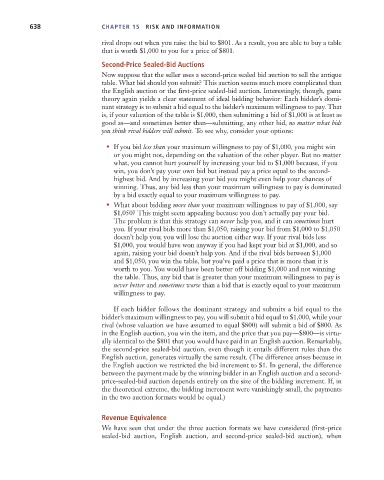Page 664 - Microeconomics, Fourth Edition
P. 664
c15riskandinformation.qxd 8/16/10 11:10 AM Page 638
638 CHAPTER 15 RISK AND INFORMATION
rival drops out when you raise the bid to $801. As a result, you are able to buy a table
that is worth $1,000 to you for a price of $801.
Second-Price Sealed-Bid Auctions
Now suppose that the seller uses a second-price sealed bid auction to sell the antique
table. What bid should you submit? This auction seems much more complicated than
the English auction or the first-price sealed-bid auction. Interestingly, though, game
theory again yields a clear statement of ideal bidding behavior: Each bidder’s domi-
nant strategy is to submit a bid equal to the bidder’s maximum willingness to pay. That
is, if your valuation of the table is $1,000, then submitting a bid of $1,000 is at least as
good as—and sometimes better than—submitting, any other bid, no matter what bids
you think rival bidders will submit. To see why, consider your options:
• If you bid less than your maximum willingness to pay of $1,000, you might win
or you might not, depending on the valuation of the other player. But no matter
what, you cannot hurt yourself by increasing your bid to $1,000 because, if you
win, you don’t pay your own bid but instead pay a price equal to the second-
highest bid. And by increasing your bid you might even help your chances of
winning. Thus, any bid less than your maximum willingness to pay is dominated
by a bid exactly equal to your maximum willingness to pay.
• What about bidding more than your maximum willingness to pay of $1,000, say
$1,050? This might seem appealing because you don’t actually pay your bid.
The problem is that this strategy can never help you, and it can sometimes hurt
you. If your rival bids more than $1,050, raising your bid from $1,000 to $1,050
doesn’t help you; you will lose the auction either way. If your rival bids less
$1,000, you would have won anyway if you had kept your bid at $1,000, and so
again, raising your bid doesn’t help you. And if the rival bids between $1,000
and $1,050, you win the table, but you’ve paid a price that is more than it is
worth to you. You would have been better off bidding $1,000 and not winning
the table. Thus, any bid that is greater than your maximum willingness to pay is
never better and sometimes worse than a bid that is exactly equal to your maximum
willingness to pay.
If each bidder follows the dominant strategy and submits a bid equal to the
bidder’s maximum willingness to pay, you will submit a bid equal to $1,000, while your
rival (whose valuation we have assumed to equal $800) will submit a bid of $800. As
in the English auction, you win the item, and the price that you pay—$800—is virtu-
ally identical to the $801 that you would have paid in an English auction. Remarkably,
the second-price sealed-bid auction, even though it entails different rules than the
English auction, generates virtually the same result. (The difference arises because in
the English auction we restricted the bid increment to $1. In general, the difference
between the payment made by the winning bidder in an English auction and a second-
price-sealed-bid auction depends entirely on the size of the bidding increment. If, in
the theoretical extreme, the bidding increment were vanishingly small, the payments
in the two auction formats would be equal.)
Revenue Equivalence
We have seen that under the three auction formats we have considered (first-price
sealed-bid auction, English auction, and second-price sealed-bid auction), when

